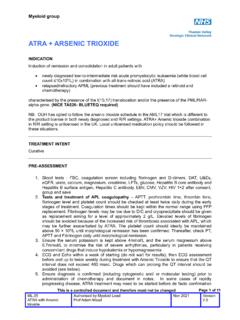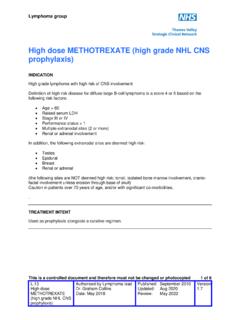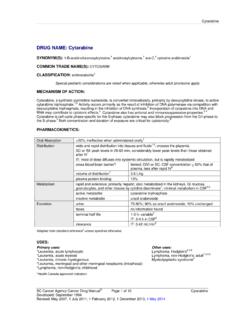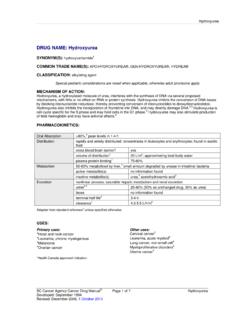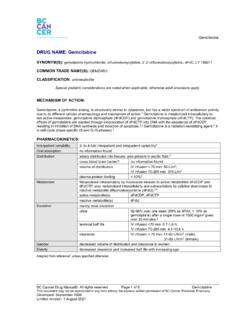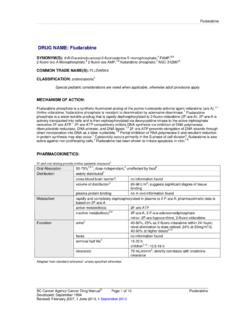Transcription of CYTARABINE (ARA-C) HIGH DOSE
1 Myeloid group This is a controlled document and therefore must not be changed CYTARABINE HD Authorised by Myeloid Lead Prof Adam Mead Oct 2019 Version Page 1 of 3 CYTARABINE (ARA-C) HIGH DOSE INDICATION Consolidation chemotherapy for AML in remission. Consider dose reduction to for patient 60 years old and for patient under 60 years old with co-morbidities at the discretion of clinician and as discussed at the MDT. TREATMENT INTENT Curative PRE-ASSESSMENT 1. Confirm diagnosis 2. Pregnancy Test - for all women with childbearing potential before each new chemotherapy course. 3. ECG +/- Echo - if clinically indicated. 4. Record performance status (WHO/ECOG). 5. Record height and weight. 6. Consent - ensure patient has received adequate verbal and written information regarding their disease, treatment and potential side effects.
2 Document in medical notes all information that has been given. Obtain written consent on the day of treatment. 7. Fertility - it is very important the patient understands the potential risk of infertility, all patients should be offered fertility advice (see fertility guidelines). 8. Hydration and tumour lysis prevention; refer to tumour lysis protocol. 9. Consider dental assessment. 10. Treatment should be agreed in the relevant MDT. 11. Central venous access should be used, Hickman line or PICC. In urgent cases it may be necessary to start chemotherapy via a peripheral cannula. DRUG REGIMEN Days 1, 3 and 5 CYTARABINE 3 g/m2 * 12 hourly in 250 mL sodium chloride intravenous infusion over 4 hours (6 doses). *Consider dose reduction to for patient 60 years old and for patient under 60 years old with co-morbidities at the discretion of clinician and as discussed at the MDT.
3 This course should usually be given once counts have recovered to: Neutrophils > 1 x 109/L AND Platelets > 100 x 109/L. Myeloid group This is a controlled document and therefore must not be changed CYTARABINE HD Authorised by Myeloid Lead Prof Adam Mead Oct 2019 Version Page 2 of 3 DOSE MODIFICATIONS CYTARABINE - discuss with consultant Renal impairment Hepatic impairment High dose 1-3 g/m2 consider GFR < 60 mL/min: give 60% dose GFR < 45 mL/min: give 50% dose GFR < 30 mL/min: omit Bilirubin > 34 micromol/L: give 50% dose Escalate doses in subsequent cycles in the absence of toxicity INVESTIGATIONS FBC, Coagulation screen. U&E, LFT. CONCURRENT MEDICATION Drug Dose and duration Aciclovir 200 mg three times a day for duration of treatment and for 3 months after completion Proton pump inhibitor As per local formulary Fungal prophylaxis According to local policy Prednisolone 1% eye drops or Dexamethasone eye drops (depending on local formulary) One drop into each eye QDS.
4 Continue for 5 days after CYTARABINE (due to risk of CYTARABINE -induced conjunctivitis). In the event of conjunctivitis consider increasing the frequency to 2-hourly until resolution of symptoms. Liaison with local ophthalmologists may be necessary in this situation G-CSF As per local policy. (No allopurinol as this is consolidation.) EMETIC RISK Das 1-5: Moderate ADVERSE EFFECTS / REGIMEN SPECIFIC COMPLICATIONS CYTARABINE Nausea, diarrhoea, oral ulceration, hepatic dysfunction. A CYTARABINE syndrome is also recognised in which patients suffer from fever, myalgia, bone pain, occasional chest pains, maculopapular rash, conjunctivitis and malaise. It usually occurs 6 to 12 hours following administration. EXTRAVASATION RISK CYTARABINE : neutral Myeloid group This is a controlled document and therefore must not be changed CYTARABINE HD Authorised by Myeloid Lead Prof Adam Mead Oct 2019 Version Page 3 of 3 TREATMENT RELATED MORTALITY 1-2% REFERENCES 1.
5 Mayer RJ, Davis RB, Schiffer CA, Berg DT, Powell BL, Schulman P, Omura GA, Moore JO, McIntyre OR, Frei E 3rd. Intensive postremission chemotherapy in adults with acute myeloid leukemia. Cancer and Leukemia Group B. N Engl J Med. 1994 Oct 6;331(14):896-903. 2. Medical Research Council AML15 Protocol. MRC Working Parties on leukaemia in adults and children. (2002). 3. UCLH - Dosage Adjustment for Cytotoxics in Hepatic Impairment (Version 3 - updated January 2009). 4. UCLH - Dosage Adjustment for Cytotoxics in Renal Impairment (Version 3 - updated January2009). REVIEW Name Revision Date Version Review date H Eagleton Review of pre-assessment, concurrent medications and mortality Feb 2016 Cheuk-kie Cheung Indication updated, general formatting Apr 2017 Cheuk-kie Jackie Cheung, Haematology Pharmacist. NSSG Myeloid Group Annual protocol meeting Oct 2019 Oct 2021







